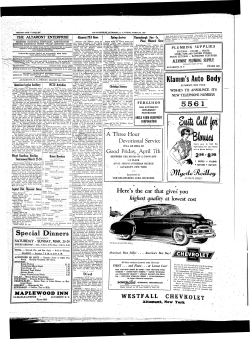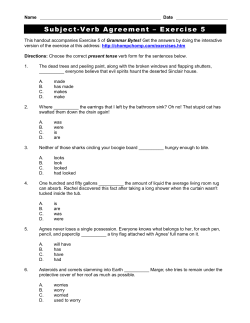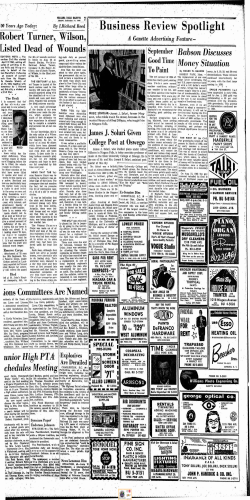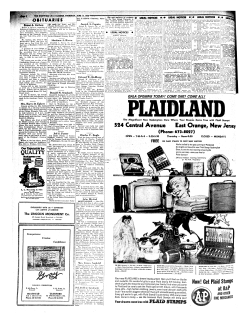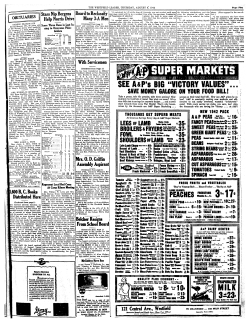
My Notorious Life, ABOUT THIS GUIDE
My Notorious Life, Reading Group Guide ABOUT THIS GUIDE is reading group guide is designed to foster conversation about My Notorious Life, and to enrich your understanding of the novel. It includes an introduction, and questions intended to help you and your reading group find interesting angles and topics to explore in the context of the story. is guide also includes a Q&A with author Kate Manning. We hope that this material will spark discussion and enhance your reading of the book. INTRODUCTION Axie’s story begins on the unforgiving streets of 1860s New York. e impoverished child of Irish immigrants, she grows up to become one of the wealthiest and most controversial women of her day. In a vivid voice, Axie recounts how she is forcibly separated from her mother and siblings, apprenticed to a doctor, and how she and her husband parlay the sale of a few bottles of “Lunar Tonic for Female Complaint” into a thriving midwifery business. Defying the law in the name of women’s reproductive rights, Axie rises from grim tenement rooms to the splendor of a mansion on Fih Avenue . When her services attract outraged headlines, Axie finds herself on a collision course with a crusading official. It takes all of Axie’s cunning and power to outwit him in the fight to preserve everything she holds dear. TOPICS & QUESTIONS FOR DISCUSSION 1. Discuss the structure of My Notorious Life. Why do you think the author chose to present the story as long lost memoir, discovered by Axie’s great-great-granddaughter, Teresa SmithhurstO’Rourke? How does Teresa’s introduction to the memoir help frame the story? Did it influence the way that you read it? If so, how? 2. Axie’s narration in My Notorious Life begins with the description of a suicide. When you finally learned whose body is in the tub, were you surprised? Why or why not? What did you think of Axie’s decision to switch identities with the deceased? 3. Compare the experiences of Axie, Dutch, and Joe aer their journy on the Orphan Train. How do you imagine Joe’s and Dutchie’s stories differed from Axie’s experience with Mrs. Temple? Discuss ninteenth century attitudes toward children as illustrated by My Notorious Life. 4. When Axie returns to 127 Cherry Street, she says, “I was home, with a taste of dread like chalk in my mouth.” (p. 54). Why do you think Axie is worried about coming home? How do the changes at 127 Cherry Street while Axie has been away also change Axie? 5. When Adelaide, one of Mrs. Evans’ patients, tells Axie, “Don’t ever trust a man who says trust me” (p. 89) Axie takes her advice as a personal motto. Discuss instances in Axie’s life where the motto is proven to be sound–or fails her. Why is the question of trust so important to Axie? What moral values does she live by? 6. When Axie is a child, her mother corrects her “savage grammar.” Axie says, “We children had poor mouths, she was forever telling us.” (p. 14) Later, when Axie is older, Charlie also corrects Axie, telling her, “ISn’t not AIN’T. Listen to me, Student, speak like the upper crust.” (p. 121) How does Axie’s language change as she recounts her story? What does language mean to Axie and Charlie in terms of social class and American self-invention? 7. Mrs. Browder says of the adult Charlie, “He’s a bounder…. Once a man of the streets, always a man of the streets,” (p. 170) and Greta says he’s “He’s one of those danglers and he’ll dangle you.” (p. 119) Do you agree with Mrs. Browder and Greta about Charlie’s character? What are your initial impressions of him? Do they change during the course of My Notorious Life? 8. Mrs. Evans tells Axie “till you have a child of your own, no woman will accept you for a midwife.” (p. 157) How do Axie’s own experiences as a woman and mother inform her work and attitudes toward the women she helps? 9. When Axie and Charlie are first married, she says, “Before we had wanted the same thing, to not be orphans no more.” (p. 169) Discuss their relationship. How does their shared background affect the way they relate to each other? 10. During an argument, Axie tells Charlie, “Free Love?... For sure, it’s not free at all.” (p. 171) What are the costs of love, as illustrated by Adelaide, Frances, Beatrice, Greta and Cordelia? 11. When Axie is put on trial, Dr. Gunning testifies against her. (p. 324) What are his motivations? How is his testimony indicative of the medical profession’s attitude toward midwifery? 12. Axie notes that the majority of the women who order Madame DeBeausacq’s Female Remedy “seemed to be married, mothers already, anxious to prevent another confinement. ey was all of them desperate.” (p. 202). Were you surprised to learn that many of Axie’s clients were married? Why? Discuss the letters that Axie receives from these women. 13. Mrs. Evans tells Axie, “a midwife must also keep comfortable with the complexities. What I call the lesser evil. You will learn not to judge too harsh on others. If you don’t learn this, you’re not suited to the work.” (p. 153) What does Mrs. Evans mean by “complexities”? What are her reasons for assisting with “premature deliveries” and why does she call them the “lesser evil”? 14. Axie says, “What is a name? It’s nothing,” (p. 412). But is it? During the course of My Notorious Life, Axie is also called Annie, Mrs. Jones, “Chickenheart,” Mother, Mme. DeBeausacq, Madame X. “Hag of Misery,” and “Modern ug of Civilized Society.” What do each of these names indicate about Axie and how she is seen by others, and by herself? 15. Anthony Comstock is a crusader against “vice.” Is Axie a crusader? Discuss and compare their apparent motivations. Comstock invites reporters along when he arrests Axie, and the press is also involved in organizing a riot against her, as well as policing that protest. How does Axie respond to the press? What was the role of the press in her life? 16. Mrs. Browder tells Axie, “Men have war to bring them their sorrows and pain…we females have our own physiology.” (p. 137) Explain what Mrs. Browder means by this statement. Do you think that Mrs. Browder’s statement helps Axie to understand Mrs. Evans’s work? ENHANCE YOUR BOOK CLUB 1. Axie and her siblings are placed in the care of the Children’s Aid Society where they are sent to the Midwest in the hopes that they’ll be adopted. Of the train ride west Axie says, “ere was only going forward on the train, the fear and the panic and the boredom.” (p. 29). To learn more about the Orphan Train movement, visit the official site of the Children’s Aid Society at http://www.childrensaidsociety.org/about/history/orphan-trains. en, read the stories of other Orphan Train riders on the Orphan Train Depot Complex http:// orphantraindepot.org/orphan-train-rider-stories/ and discuss how the stories on the site compare to that of Axie and her siblings. 2. While Frances Harkness, one of Mrs. Evans’s patients, is recovering, she asks Axie to read Elizabeth Barrett Browning’s “Sonnets from the Portuguese” with her. Axie is deeply moved by the sonnets, saying “all my life I remembered Love’s Sake Only, and Mrs. Browning’s poetical lines. One in particular tormented me, where she wrote, Behold and see What a great heap of grief lay hid In me, And how the red wild sparkles dimly burn rough the ashen grayness.” (p. 109) Read Browning’s “Sonnets from the Portuguese” paying particular attention to “I li my heavy heart up solemnly” and “Love’s Sake Only.” Discuss why these poems would haunt Axie. 3. Axie makes a fortune selling “Lunar Tablets for Female Complaint,” and Charlie ultimately expands their customer base through advertising. Read this article about Patent Medicine from e Daily Mail: http://www.dailymail.co.uk/news/article-2198086/Victorian-advertshealth-remedies-laden-cocaine-morphine-alcohol.html and compare Charlie’s advertisements with those that are pictured. 4. e women who write to Axie are drawn from the women who wrote to Margaret Sanger, the founder of Planned Parenthood. To read those letters, visit: http://historymatters.gmu.edu/d/ 5083/ To learn more about the research that went into My Notorious Life and connect with Kate Manning online, visit her official site at http://katemanningauthor.com/ My Notorious Life is based on Ann Trow Lohman, an early nineteenth-century abortionist figure, known as Madame Restell. What inspired you to create a character based on her? I didn’t begin with Madame Restell. e story was first about a child on the New York streets in the 1850s. As Axie met misfortunes and got swept up in the social reform of the era, I wondered what would become of her. In the course of figuring it out, reading history, I stumbled on the story of Ann Lohman, and was flabbergasted—why had I never heard of her? She was in the headlines for decades. e more I thought about her, the more I realized that it made perfect sense that Axie, a little girl who had seen so much tragedy befall women and children, would grow up to share Lohman’s profession. Axie already seemed to have the fierceness of spirit that would give her the courage to stand up to authority. I liked the challenge and risk of exploring this charged and difficult material. Axie Muldoon has a truly distinctive voice. Marisa Silver has lauded her “as fierce and alive a character as I have read in recent fiction.” How did you capture her unique speech and attitude? Since voice is the first thing that compels me to read a novel, I set out to learn from the ones I like best, which are as diverse as Junot Diaz’s e Brief Wondrous Life of Oscar Wao, William Faulkner’s e Sound and the Fury, Peter Carey’s True History of the Kelly Gang, or eir Eyes Were Watching God by Zora Neale Hurstson. To get the voice I was aer, I wanted to mix the syntax and rhythms of New York and the phrasing and lilt of Ireland into Axie’s speech. I used slang dictionaries, such as e Secret Language of Crime, published in 1859 by NYC police chief George Matsell. My notebook is full of expressions and words from old manuals like e American Frugal Housewife by Lydia Marie Child, and novels like Stephen Crane’s Maggie, a Girl of the Streets. A few favorites from my notebook: “savage as a meat ax,” “dumb as a haddock on Friday.” But really, what animated Axie’s voice for me was emotion. Her anger and mercy and longing for a family. A strong voice has to have need at its core, I think. In your author’s note, you say that although My Notorious Life is based on historical facts, you have “reconfigured events…when such changes suited the story” (p. 435) What liberties did you take for the sake of the story? Probably too many to count. I hate to describe them, for fear of breaking the illusion created by a fictional world and turning it into a detective hunt for what’s “true” in the book. at said, a curious reader could easily discover which newspaper articles in the book were really written about Ann Lohman, or which ads for “remedies” were the real ones from that time period. More generally, abortion laws were undergoing big changes in the nineteenth century. I purposely stayed obtuse about their exact chronological evolution—in order to fit Axie’s story into a period between 1850 and 1880. It seemed sufficient for the purposes of a novel just to evoke the general idea that the tide was shiing. Emma Donoghue calls My Notorious Life “a gripping docu-drama.” Did your background as documentary television producer help as you researched the book? How so? Can you talk about your writing process? Emma Donoghue knows a thing or two about writing good drama, so her comment means a lot to me. And it’s true that my background in television and journalism taught me a great deal–in terms of research, certainly. But most importantly, it made me focus on dramatic structure. On television, you have to keep things interesting. You want people to come back to the news aer the commercial, come back to the show for the next installment. So you must choose only scenes that tell the story most compellingly. You are always cutting, to fit to an allotted time slot. Nonfiction writing also teaches a novelist how to “find the story,” and then hang it on the bones of fact. Straight facts are not memorable. Stories are. And that’s because stories are colored by emotion and human detail. As for “writing process.” at sounds as if I could flip a series of switches and Poof! A book. But the process, if it is one, is one of fits and starts, epiphanies followed by fog. ere’s a lot of driing around and looking in the refrigerator, a sudden need to walk the dog. In an ideal world, this “writing” would happen every day, though it never does. Life interrupts, oen for weeks and months at a time. In a good stretch, I sit down early in the morning and don’t stop till late aernoon. Getting it right is a slog. It’s laying tile. Some days I forge ahead—a new scene, a new bit of dialogue. Many, many days I rework the prose, shaping, trimming, moving passages. I ditch at least as much material as ends up in the book. Bits from the middle wind up at the beginning, and vice versa. Sometimes I can drudge on for hours and not even be sure what I accomplished. Maybe I moved a comma. While researching My Notorious Life, were there any discoveries you made about Ann Trow Lohman or her contemporaries that were particularly surprising to you? If so, what were they? What was quite surprising was how she seemed to have a rather equal partnership with her husband Charles Lohman. ey were quite free-thinking compared to how we usually imagine the Victorians. Another thing that struck me was the degree to which Lohman —“Madame Restell,” was extraordinarily competitive with other so-called “females” physicians’ of the day, running counter-ads disparaging her rivals—Mrs. Bird and Mrs. Costello—calling them frauds and imposters. Was she motivated by greed? by politics? by a sense of injustice? Very little is known about her in that regard. Most shocking to learn was that in the 1800s, there were some 30,000 homeless children living on New York City streets. Some of these kids were as young as two—shoeless and sleeping on steam grates. It was astonishing to see that when the kids were shipped away on the Orphan Trains, the Childrens Aid Society didn’t keep records on adoptions for some time. Child welfare is better in many respects now, though it’s discouraging that in New York in 2013, there are still some 25,000 homeless children living in shelters, and some older children still live on the street. My Notorious Life tackles the issue of women’s reproductive rights head on. What would you like readers to take away from My Notorious Life in their consideration of women’s rights? I hope that this novel is nuanced enough to provide a long view of current social issues. Women have had to fight for birth control and reproductive rights for a long time, and are still doing so, with the same arguments as in our great-great-grandmothers’ day, only now informed by technology and advanced medicine and changes in womens’ roles and power. I would hope readers take away the idea that, as Mrs. Evans says to Axie, we must all grapple with the “complexities” but also bear in mind where we have come from, as women, and as a society, and how our understanding evolved, and is evolving. How did the writing of My Notorious Life compare to that of Whitegirl, your critically acclaimed debut novel? When I wrote Whitegirl, I’d never written a novel before. I had to learn on the job. And what’s more, I was terrified to be writing not just as a novice novelist, but about race, specifically whiteness, telling a love story and psychological mystery about a white woman and a black man. is was, and still is, a storyline that raises eyebrows not to mention hackles in some quarters. With My Notorious Life, the work was both easier and harder. Easier because I understood myself as a novelist. But it was harder, too, because I had to research everything. Axie could not walk the streets or do her chores or become a midwife without me having to run to the annals of history to figure out what that was like. Writing, though, never really gets easier. Each novel has a great deal to teach the writer. Each story has its own problems and obstacles in the telling. And the next one will be—is—just as challenging in its way as the others. What writers inspire you? So many! Here’s a partial list: Edna O’Brien, Flannery O’Connor, Toni Morrison, Junot Diaz, Wallace Stevens, Grace Paley, ZZ Packer, Virginia Woolf, Emma Donoghue, Annie Proulx, Sebastian Barry, Roddy Doyle, Alice Walker, Gunter Grass, E.L. Doctorow, Roald Dahl, Sapphire, Phillip Pullman, Peter Carey, Vladimir Nabokov, Charles Johnson, Marisa Silver, Kate Atkinson, Colum McCann, Whitney Otto, Margaret Atwood, Charles Dickens, Keri Hulme, M.S. Bell, Mary Karr, Kate Summerscale, Sarah Waters, Russell Banks, David Schickler, Colm Toibin, Amy Wilentz, Mother Jones, Cornelius Eady, Norman Rush, Louise Erdrich, George Saunders... I could keep going. I have le important ones out. Shakespeare, for example. As both a writer and teacher of creative writing, is there any advice that you can offer aspiring authors? Don’t only aspire. Do the work. Put the words down. Edit, trim: Invest in a scalpel and a pair of shears. Avoid sentimentality. Avoid cliche. Sharpen your senses: really notice the world around you and describe it to yourself or to a notebook as you go around. is is a good habit, even for non-writers. ose who practice it will never be bored, and at the very least you’ll have a memoir for the ages.
© Copyright 2025
